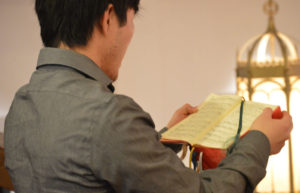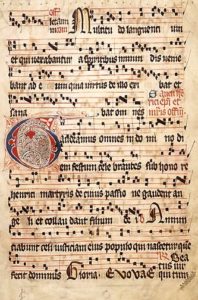In this series, “A More Complete Education,” we take up key authors, ideas, composers, and artists, who have contributed to the Catholic intellectual tradition and the patrimony of western culture. Topics related to this broad theme also find their place. Articles in this series introduce readers to subjects which are of interest to students from the age of fifteen to ninety-five.
First of all, let’s dispel the idea that chant is only part of the Church’s past. Vatican II called for the renewal of sacred music through the restoration of this musical patrimony, stating that “it should be given pride of place in liturgical services.” In second position to chant the council placed motets and other polyphonic works, which grew from chant and includes the great compositions of Josquin, Byrd, Tallis, and Palestrina. Ironically, the council that is often thought to have sent sacred chant into obscurity had instead sought to place it on firmer ground, renew its practice, and extend it to the broader Church, especially to the laity. Contrary to popular opinion, to fully implement Vatican II, parishes should begin by taking up chant again.

But wouldn’t this require everyone to learn Latin? Not so fast. First of all, in an age of almost universal literacy and the printing press, the older Latin chant would be intelligible to all if a translation were provided in the weekly Church bulletin or in books included in each pew. If we can make room in the bulletin for an announcement about the upcoming bake sale, we should be able to give a few lines for the words of Sacred Scripture that will be sung in the Sunday liturgy.
And furthermore, while Gregorian chant does refer to music set to Latin, the term “chant” also includes chant with English texts that has been composed recently but that retains the beauty and reverence of the older tradition. The council foresaw a living tradition of sacred music that took Gregorian chant as its model and animating source but that also grew to include new forms and modes in organic continuity with it. After nearly a decade of creative hard work, composers and publishers have given to the Church a treasure of resources that include simple, beautiful, reverent chant in English that could be learned quickly and sung easily by every parish choir and cantor in the United States.

But how would this change our liturgies? There are three basic classes of chant that the Church asks us to sing: (1) the responses, e.g., “The Lord be with you,” “And with your spirit,” (2) the Ordinaries (e.g., Kyrie, Gloria, Sanctus, and Agnus Dei), and (3) the Propers. Fortunately, every parish already has (1) or (2) in a spoken or sung form. It would only require the parish to move from speaking to singing or from singing a non-chant form to a chant form. And the people in the pews can easily learn these over time with the help of the choir and the leadership of the priest. Number (3), the propers, have been traditionally reserved to the choir or a soloist, but even these can be easily learned in the same or less time required to learn a non-chant piece for that Sunday.
Finally, let us conclude where we began: “What is Gregorian chant?” In short it is the body of sacred song in the western Church that consists of a single line of music (with no harmonies), sung without instruments, usually in Latin (except the Kyrie which is in Greek), and which developed largely in the ninth and tenth centuries, growing from a synthesis of Roman and Gallican sources.
Of course, much, much more could be said. This is only the tip of the iceberg. Those who would like to know more should read …
… But before diving into the deeper waters, experience some Gregorian chant for yourself if you have not already. This Latin chant is the first chant of the Mass for the first Sunday of Advent and is combined with beautiful images from an early chant manuscript.
“Tra le Sollecitudini” for those who would like to see how the Church began the reclamation of sacred chant at the beginning of the twentieth century.
“Sacramentum concilium” to learn what the Second Vatican Council had to say about chant and the sacred liturgy.
For a historical introduction to chant, David Hiley’s Gregorian Chant is an excellent place to begin.
And visit the Church Music Association of America to learn more about resources, conferences, and workshops.
To request a recording of sacred music by the Magdalen Choir of the Liberal Arts, please e-mail [email protected]
